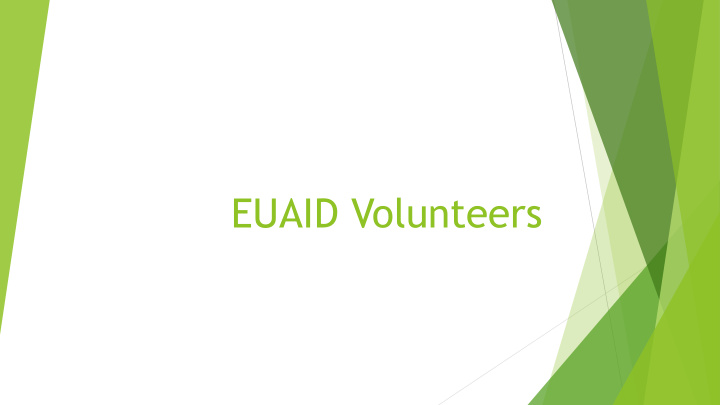



EUAID Volunteers
Identification of needs: Context Analysis – stakeholders/ beneficiaries Project Project design Management Evaluation / lessons learned Construction resource management drawings, materials maintenance
Project Clarification This presentation will address the necessary analysis and key aspects of the project formulation phase and project management/implementation. The clearer the project is formulated, the easier it is for organisations to implement the project and evaluate it. Clarity and transparency in project formulation and implementation require careful consideration of several aspects. An objective/problem tree may offer multiple project opportunities or approaches Stakeholder analysis, target group analysis, Resource analysis Risk analysis etc. The task is hereafter to identify a way to the right approach by using the Logical Framework Approach, LFA.
Key Considerations Ambition – Are the objectives realistic and do they have good indicators or • success criteria? • Target group - Is it well-defined and realistic? Who are the primary / secondary target groups? Strategy - Why execute the project in a certain way – have other options been • considered? Context – Have factors outside the project been taken into account? What other • organizations or individuals will be affected / involved? Resources – Is the project realistic in relation to own and the partner • organization's resources?
Logical Framework Approach (LFA) The Logical Framework Approach is a method, which has been used in development work for many years It is useful in creating an overview of the different processes and considerations related to a project. LFA is designed to support planning and implementation of development projects - I.e. activities that are planned to achieve specific objectives within a defined budget and within a stipulated time period LFA is used as a basis for various donor organisations - including Danida the EU's development funds etc.
project concept „ The discussion of the project concept could start from the formulation of a series of questions that relates to the problems of community, A fundamental project problem may be phrased as a question: Why is there such deep poverty, low living standards and health problems? • Why are access to clean/safe water a re-occurring challenge? • Afterwards it is rephrased into an objective …ensure safe water reduce poverty Analysis of objectives .. will achievement contribute in solving problems, Analysis of Resources of organisation, partners and donors financial resources, human resources, organisational/institutional
STAKEHOLDER ANALYSIS The purpose of the stakeholder analysis is to provide a description of the persons, organisations and institutions with a stake in the project. Stakeholders are mapped on the basis of reflections as to who might be interested in the project issue to be addressed. the categories with which we want to operate, for instance, whether it is relevant to divide an overall group – such as farmers – into women and men, or into land-owners and landless. The analysis focuses on the stakeholders’ relation to the intervention, their interest (motivation), their fears regarding the project, as well as potential strengths and weaknesses. It is important to include: The people intended to benefit from the project The people to be involved in implementing the project Organisations and institutions with direct or indirect influence on the project Decision-makers who indirectly exert significant influence on the project
Stakeholder Analysis Primary Involve Interest in Fear of Strengths Weaknesses stakeholders ment in project project /Risks the project Village inhabitants Male/female/ Ministries Councils Local authorities other
Target Group Analysis Primary Involvem Interest in Fear of Strengths Weaknesses/risks Target Group ent in project project / the Beneficiaries project I Village inhabitants Male/female/ children Educational institutions staff/students Etc.
LFA matrix
Terminology Development objectives, goal to which project is contributing in achieving in the long term attribution not only to specific project Immediate objectives, goals to be obtained by project Outputs or projects to be produced by end of project a changed situation to be verified time, location, target group, substantial qualitative change and quantitative change.. / asking when, where, who, what how much Actions are the concrete events taking place as part of project Inputs financial, equipment and human resource contributions Indicators to be relevant, specific and measurable / reliable Assumptions / external conditions for which the project do not have control but on the other hand rely on for successful realisation Assumptions are to be assessed importance relevance and importance of assumptions
Recommend
More recommend